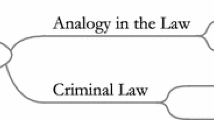Abstract
This paper adopts a legal perspective to counter some exaggerations of today’s debate on the social understanding of robotics. According to a long and well-established tradition, there is in fact a relative strong consensus among lawyers about some key notions as, say, agency and liability in the current use of robots. However, dealing with a field in rapid evolution, we need to rethink some basic tenets of the contemporary legal framework. In particular, time has come for lawyers to acknowledge that some acts of robots should be considered as a new source of legal responsibility for others’ behaviour.
Similar content being viewed by others
References
Abernathy CF (2006) Law in the United States. Thomson West, St. Paul
Aleksander I, Dunmall B (2003) Axioms and tests for the presence of minimal consciousness in agents. In: Holland O (ed) Machine consciousness. Imprint Academic, Exeter, pp 8–18
Allen C, Varner G, Zinser J (2000) Prolegomena to any future artificial moral agent. J Exp Theor Artif Intell 12:251–261
Asaro P (2007) Robots and responsibility from a legal perspective. In: Proceedings of the IEEE conference on robotics and automation: workshop on roboethics. Rome, 14 April 2007
Asimov I (1942) Runaround. Doubleday, New York
Asimov I (1985) Robots and empire. Doubleday, New York
Barrio F (2008) Autonomous robots and the law. Society for computers and law. Retrieved August 15th, 2009, from http://www.scl.org/site.aspx?i=ho0
Bekey GA (2005) Autonomous robots: from biological inspiration to implementation and control. The Mit Press, Cambridge
Bynum TW (2006) Flourishing ethics. Ethics Inf Technol 8:157–173
Clarke R (1993) Asimov’s laws of robotics: implications for information technology. IEEE computer 26(12):53–61 and (1994) 27(1):57–66
Comanducci P (2006) Le tre leggi della robotica e l’insegnamento della filosofia del diritto. Materiali per una storia della cultura giuridica XXXVI 1:191–197
Dennett D (1997) When HAL kills, who’s to blame? In: Stork D (ed) HAL’s legacy: 2001’s computer as dream and reality. MIT Press, Cambridge, pp 351–365
Epstein RG (1997) The case of the killer robot. Wiley, New York
Ewald W (1995) Comparative jurisprudence (I): what was it like to try a rat. Am J Comp Law 143:1889–2149
Floridi L (2007) Artificial companions and their philosophical challenges. E-mentor 5(22):84–86
Floridi L, Sanders JW (2005) On the morality of artificial agents. Mind Mach 14(3):349–379
Franklin S (2003) IDA: a conscious artifact? In: Holland O (ed) Machine consciousness. Imprint Academic, Exeter, pp 47–66
Hart H (1961) The concept of law. Clarendon Press, Oxford
Karnow CEA (1996) Liability for distributed artificial intelligence. Berkeley Technol Law J 11:147–183
Katz A (2008) Intelligent agents and internet commerce in ancient Rome. Society for computers and law. Retrieved August 15th, 2009, from http://www.scl.org/site.aspx?i=ho0
McFarland D (2008) Guilty robots, happy dogs: the question of alien minds. Oxford University Press, New York
Moravec H (1999) Robot: mere machine to transcendent mind. Oxford University Press, New York
Pagallo U (2009) Sul principio di responsabilità giuridica in rete. Il diritto dell’informazione e dell’informatica XXV(4–5):705–734
Pagallo U (2010) The human master with a modern slave? Some remarks on robotics, ethics, and the law. In: Arias-Oliva M, Bynum TW, Rogerson S, Torres-Corona T (eds) Ethicomp 2010: the “backwards, forwards and sideways” changes of ICT. Universitat Rovira I Virgili, Tarragona, pp 397–404
Reynolds C, Ishikawa M (2007) Robotic thugs. In: Bynum TW, Rogerson S, Murata K (eds) Ethicomp 2007: glocalisation. Global e-SCM Research Center & Meiji University, Tokyo, pp 487–492
Solum LB (1992) Legal personhood for artificial intelligence. North Carolina law rev 70:1231–1287
Ŝtaerman EM, Trofimova MK (1975) La schiavitù nell’Italia imperiale. I-III secolo. Editori Riuniti, Roma
Teubner G (2007) Rights of non-humans? Electronic agents and animals as new actors in politics and law. Max Weber Lecture at the European University Institute of Fiesole, Italy on 17th January 2007
Veruggio G (2007) Euron roboethics roadmap. In: Proceedings Euron roboethics atelier. February 27th-March 3rd, 2006, Genoa, Italy
Watson A (1988) The digest of Justinian, vol I. University of Pennsylvania Press, Philadelphia
Zimmermann R (1988) The law of obligations. Roman foundations of the civilian tradition. Clarendon, Oxford
Author information
Authors and Affiliations
Corresponding author
Rights and permissions
About this article
Cite this article
Pagallo, U. Killers, fridges, and slaves: a legal journey in robotics. AI & Soc 26, 347–354 (2011). https://doi.org/10.1007/s00146-010-0316-0
Received:
Accepted:
Published:
Issue Date:
DOI: https://doi.org/10.1007/s00146-010-0316-0




